It’s a good idea to clip goats in springtime – it gets rid of the excess hair before summer’s hot weather, makes 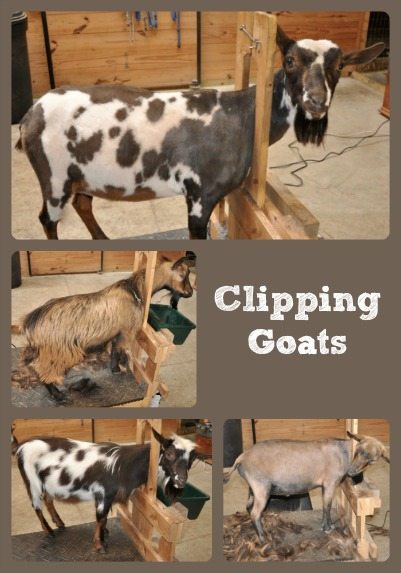
We generally clip adults in spring after the weather has warmed up in the daytime to the 60’s, but might not clip any of the current year’s kids until it’s a little warmer so they don’t get chilled.
Recommended Clippers
We use an Andis (model AGC2) pet clipper (the type that is sold for dogs) because we have Nigerian Dwarf goats and the smaller blades on these types of clippers follow the contours of the smaller Nigerian Dwarf bodies better than larger clippers. Oster also makes similar clippers. For standard size goats, the Lister Star or clippers by Premier 1 Supply also do a good job and have larger blades (about 3″ wide) that get the job done quickly for the larger breeds.
When getting the Andis or Oster type pet clipper, it’s a good idea to get a 2 speed version because the faster speed performs better on longer hair. A professional model is also recommended if you’re going to be trimming many goats. Finally, make sure that the clipper runs quietly, goats don’t like being clipped with loud clippers.
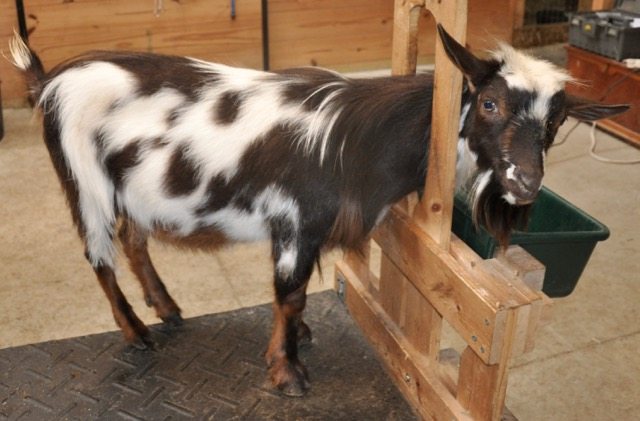
Bramblestone Celtic Quinn Prior To Spring Clipping
Which Blades & Other Essentials
In the springtime, a #4 blade for the bodies and #10 blade for the legs/face is a good place to start when the weather is still cool. If the weather is warmer, then a #7 blade for the bodies and #10 for the legs/face work well. For the Lister Star type clipper, starting with the “coarse” blade in springtime is recommended if it’s still cool at night. The “medium” blade is usually adequate in hot weather.
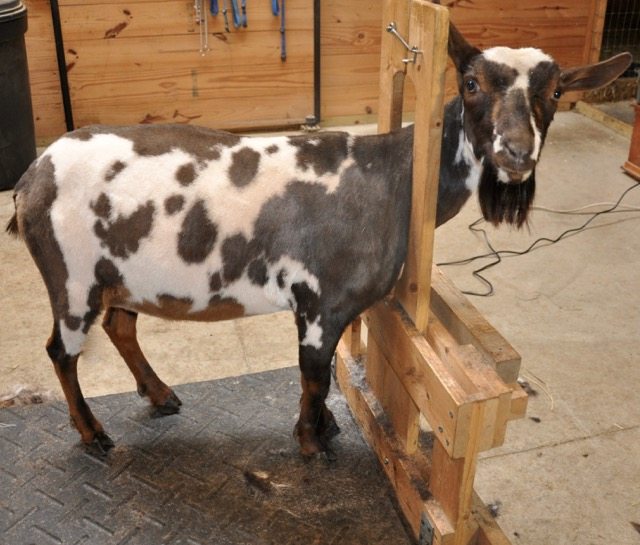
Bramblestone Celtic Quinn After Spring Clipping
It’s important to have the recommended lubricant on hand for the clipper (they should be lubricated frequently – every 5 – 10 minutes), and it’s also convenient to have spray lubricant/coolant on hand for the blades. After prolonged clipping, they start getting warm quickly and the coolant/lubricant helps prevent them from getting too hot. Another idea is to have multiple blades of each size so they can be switched out when they get hot.
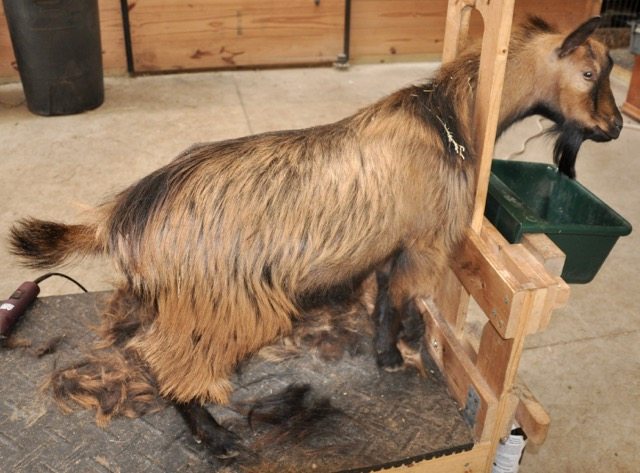
Bramblestone Mighty Quinn Halfway Thru Clipping
The Spring Clipping Process
Starting with the #7 (or #4 if using) blade start at the rear hock and trim up following the flank of the goat in one long motion (always trim against the way the hair lies). For the next stroke, move over next to the first pass and follow the same path. Continue in this way and clip up the main body and stomach. For the front and neck, start at the knee and clip upward in one stroke following the neck upward. After clipping all of one side, start rear hock and repeat for the other side.
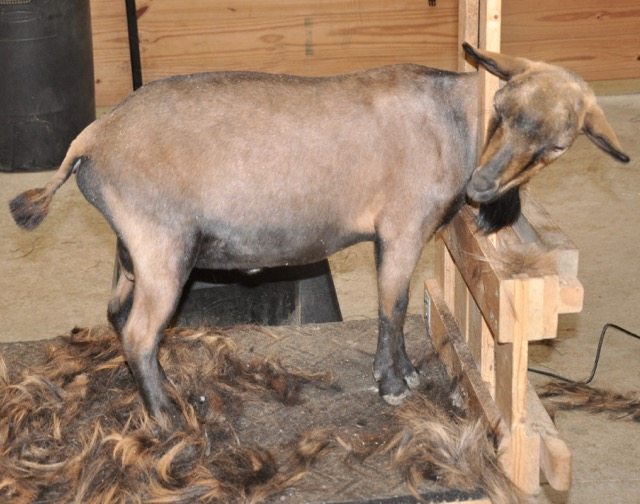
Bramblestone Mighty Quinn – What Have You Done To Me?
Once the entire neck and body have been clipped, switch to the #10 blade and starting at the hoof, trim upward to the knee or hock – trimming in this manner all the way around all four legs. Then trim the tail, leaving at least a 1/2 tuft of hair on the end of the tail. For does, trim the udder very carefully, trimming agains t the way the hair lies on the udder (I switch to a #50 blade for the does udder, but that’s just the way I like to do it). Finally, trim against the way the hair lies on the face, being extremely careful around the eyes. For bucks, it’s standard practice to leave them with a “beard” to appear masculine.
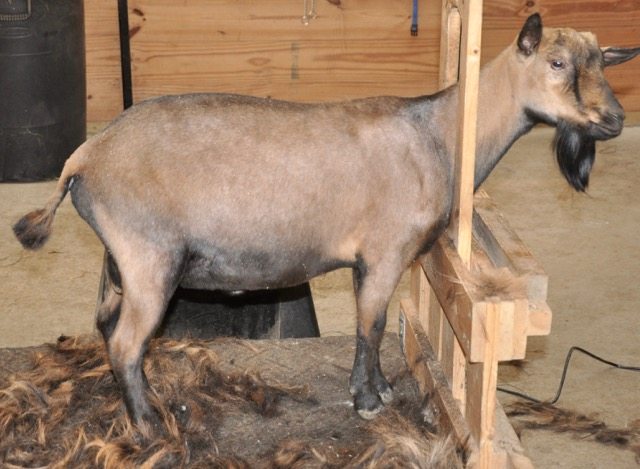
Bramblestone Mighty Quinn After Spring Clipping – Note Tail Tuft & Beard
If you’re planning to attend a show after clipping, it’s always a good idea to do the clipping about a week in advance. That way, you can “tidy-up” any areas you may have missed, and a little growth makes the coat look smooth.
Heath says
So I think I trimmed to much and now my goat is sunburn.. what can I do. We shaved him down due to lice and now he is so sun burn.. fyi we live in Florida. I feel horrible so please don’t make fun.. what can I do to help his pain?
Lesa says
Hi Heath,
I wouldn’t make fun. The first time I trimmed our pink-skinned/white doe, she got sunburned too! Of course, now keep him in the shade if you can. To help prevent sunburn, we found that regular human sunscreen (the sports block aerosol kinds seem to work well) sprayed on susceptible areas helped. As far as what to do to help the pain now, I guess it depends on how bad it is. After sunburn, my goats seemed to spring back pretty well without additional help. But, if it was a really bad case, I would call the Vet. They can help with medications for pain relief or cremes for skin relief.
kourtney says
Just so I understand, you went backwards against the hair with a #7? So did that give you a #10 finish? I’m asking because I’m thinking about using a #10 all over instead, but I’m not sure if the backwards #7 would leave a smoother appearance (less lines). Sorry for all of the questions! Love your blog 🙂
Lesa says
Hi Kourtney, yes I went backwards against the hair with a #7 on the body. When I use a #10 I also go backwards against the hair. So, no the #7 does not give me as close a cut as the #10, but that’s what I’m looking for. A slightly longer trim on the body with the #7, and a closer trim on the legs and face with the #10. I’m sure you could use a #10 all over, it would give you a very close trim.